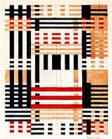
textile -
A cloth, usually made by weaving
or knitting fiber or yarn;
a fabric. Materials might include fibers of raffia,
wool, cotton, linen, silk,
or synthetics, among others.
Examples:

Egypt, Thebes, Sheet of Royal Linen, c. 1466 BCE,
Dynasty 18, reign of Hatshepsut 6-7, linen,
greatest width 63 3/8 inches
(161 cm), greatest length
16 feet 11 inches (515 cm), weight
2.9 ounces (140 g), 118
warp, 77 weft
per square inches (46 warp, 30 weft per square cm), Metropolitan
Museum of Art, NY. See Egyptian
art.

Russia, Eastern Altai, Pazyryk Burial Mound
5, Pile Carpet (fragment),
5th-4th centuries BCE,
wool, length 183 cm, width 200 cm, Hermitage Museum,
St. Petersburg, Russia.

Mongolia, burial mound at Noin-ula, Embroidery with a Benedictory Motif,
1st century BCE,
silk, 39.5 x 35.7 cm, Hermitage Museum, St. Petersburg, Russia.
See embroidery.

China, Silk Panel (fragment), 1st century CE,
woven silk, 35 x 184 cm, Hermitage Museum, St. Petersburg, Russia.
Persia / Iran or Egypt, Sasanian, Textile Fragment, 7th or 8th century CE, wool, cotton, 8 3/4 x 4 1/2 inches (22.2 x 11.4 cm), Metropolitan Museum of Art, NY.

Yemen, Tiraz fragment, 10th century CE,
cotton, ink, and gold leaf, plain weave
with painted decoration,
23 x 16 inches (58.4 x 40.6 cm), Metropolitan Museum of Art,
NY. See Islamic
art.
Chinese, Cloth of Gold, after 1220, cloth of gold, lampas weave, silk and gold thread, height 134.5 cm, Cleveland Museum of Art. See Chinese art.
South America, Central Andes, Central Coast, Chancay, Openwork Headcloth, Late Intermediate Period, 1000-1470 CE, cotton, embroidered square mesh openwork, 32 x 32 inches (81 x 81 cm), Michael C. Carlos Museum, Emory U, Atlanta, GA. See Pre-Columbian art.

Turkey, Animal Carpet, 14th century, wool, pile
weave, wool pile on wool foundation, 85 symmetrical
knots per square inch, 60 1/4 x 49 1/2 inches (153.04 x 125.73
cm), Metropolitan Museum of Art, NY.

Turkey, Dragon and Phoenix Carpet, beginning
of the 15th century, wool, Museum for Islamic Art, Berlin. This
East Asian dragon and phoenix motif
arrived in Asia Minor with Mongolian marauders. See Islamic art.

Egypt, Mamluk, "Simonetti" Carpet, c. 1500,
wool, pile weave, wool pile on wool foundation, c. 100 asymmetrical
knots per square inch, 29 feet 7 inches x 7 feet 11 1/2 inches
(896.62 x 238.76 cm), Metropolitan Museum of Art, NY.
French, Time, c. 1500-1510, tapestry with wool and silk, Cleveland Museum of Art.

Turkey, Pile
Carpet, second half of the 16th century, wool, 331 x
188 cm, Hermitage Museum, St. Petersburg, Russia.

Turkey, Bursa or Istanbul, Ottoman, Textile fragment, second half of the
16th century, silk and metal thread, a compound weave (satin
and twill), 48 x 26 1/2 inches (121.9 x 67.3 cm), Metropolitan
Museum of Art, NY. See Islamic
art.
![]()
Persia / Iran, Safavid dynasty, Flowering Plant beside a Pond, first
half of 17th century, silk: cut, voided satin, velvet, brocaded,
Worcester Art Museum, MA. See Islamic
art.

India, Mughal dynasty, Reign of Shah Jahan, Tree Rug, first half of the 17th century, wool and cotton, 89 1/2 x 75 1/2 inches (227 x 192 cm), Frick Collection, NY.

India, Mughal dynasty, Reign of Shah Jahan, Carpet with Floral Pattern, first half of the 17th century, wool and cotton, 76 x 46 inches (193.04 x 116.8 cm), Frick Collection, NY.

England, Needlework Framed Picture, third quarter
of the 17th century, silk on canvas,
13 x 20 1/2 inches (33 x 52.1 cm), Metropolitan Museum of Art,
NY.

France, Paris, Air, c. 1683, petit point hanging made
with silk, wool, metal thread on canvas
316 stitches per square inch, 49 stitches per square cm, 14 feet
x 9 feet (426.7 x 274.3 cm), Metropolitan Museum of Art, NY.

Savonnerie Manufactory (Paris, France), Music, c. 1685-1697, XVII century, carpet
made with wool Ghiordes knot, 90 knots per square inch, width
16 feet (487.7 cm), length
29 feet 6 inches (899.2 cm), Metropolitan Museum of Art, NY.

France, Flounce of Guipure Lace, late 17th-early
18th centuries, linen
thread, needlepoint, 60 x 177 cm, Hermitage Museum, St. Petersburg,
Russia.

Belgium, Brussels, Flemish, Lace: Rabat, mid-18th century, 12 1/2
x 17 1/2 inches (31.8 x 44.5 cm), Metropolitan Museum of Art,
NY.

Indonesia, Sumatra, south central Lampung
region, Lampung people, Ceremonial Banner, 18th century, cotton,
beads, nassa shells, fiber,
length 48 1/2 inches (123.2
cm), Metropolitan Museum of Art, NY. This banner is of a type
called a "ship cloth", and is perhaps the finest surviving
example.

Ghana, Blanket, 19th century, cotton, wool,
51 inches x 10 feet (129.5 x 304.8 cm), Metropolitan Museum of
Art, NY. See African
art.

United States, Arizona, Navajo peoples, Wearing Blanket, 1860-70, wool, 69 x
48 inches (175.3 x 121.9 cm), Metropolitan Museum of Art, NY.

United States, New York, Crazy Quilt, c. 1890, silk, velvet, ribbons,
cotton, 60 3/4 x 52 inches (154.3 cm x 132.1 cm), Metropolitan
Museum of Art, NY.

Designed by William Morris (British, 1834-1896),
made/manufactured by Morris and Company, Merton Abbey, England,
Length of Printed Cotton, 19th-20th century,
cotton, 8 feet 7 1/2 x 38 1/4 inches (262.9 x 97.2 cm), Metropolitan
Museum of Art, NY. See Arts
and Crafts Movement.

Anni Albers (born Analise Fleischman, married
Josef Albers) (German, 1899-1994), Design for Wall Hanging, 1926, gouache and pencil
on paper, 14 x 11 1/2 inches (35.6
x 29.2 cm), Museum of Modern Art, NY. See Bauhaus and design.

Claire Zeisler (American, 1903-1991), Tri-Color Arch, 1983-84, hemp, synthetic
fiber, top: 74 x 11 inches (183 x 27.9 cm), height
of bottom 58 inches (147.3 cm), Metropolitan Museum of Art, NY.
Also see basket,
canvas, chinoiserie,
costume, embroidery,
Index of American Design,
mola, Mughal
dynasty, sampler, tapestry, tartan, and wire.
https://inform.quest/_art